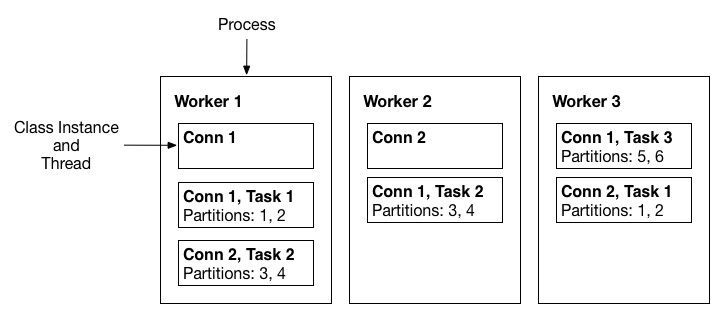Concepts¶
Kafka Connect is a framework to stream data into and out of Kafka. The Confluent Platform ships with several built-in connectors that can be used to stream data to or from commonly used systems such as relational databases or HDFS. In order to efficiently discuss the inner workings of Kafka Connect, it is helpful to establish a few major concepts.
- Connectors – the high level abstraction that coordinates data streaming by managing tasks
- Tasks – the implementation of how data is copied to or from Kafka
- Workers – the running processes that execute connectors and tasks
- Converters – the code used to translate data between Connect and the system sending or receiving data
Connectors¶
Connectors in Kafka Connect define where data should be copied to and from. A connector instance is a logical job that is responsible for managing the copying of data between Kafka and another system. Connector plugins are jars that add the classes that implement a connector. Both connector instances and connector plugins may be referred to as “connectors”, but it should always be clear from the context which is being referred to (e.g., “install a connector” refers to the plugin, and “check the status of a connector” refers to a connector instance).
We encourage users to leverage existing connectors. However, it is possible to write a new connector plugin from scratch. At a high level, a developer who wishes to write a new connector plugin follows the workflow below. Further information is available in the developer guide.

Tasks¶
Tasks are the main actor in the data model for Connect. Each connector instance coordinates a set of tasks that actually copy
the data. By allowing the connector to break a single job into
many tasks, Kafka Connect provides built-in support for parallelism and scalable data copying with very little
configuration. These tasks have no state stored within them. Task state is stored in Kafka in special topics config.storage.topic and status.storage.topic
and managed by the associated connector. As such, tasks may be started, stopped, or restarted at any time in order
to provide a resilient, scalable data pipeline.

High level representation of data passing through a Connect source task into Kafka. Note that internal offsets are stored either in Kafka or on disk rather than within the task itself.
Task Rebalancing¶
When a connector is first submitted to the cluster, the workers rebalance the full set of connectors in the cluster and their tasks so that each worker has approximately the same amount of work. This same rebalancing procedure is also used when connectors increase or decrease the number of tasks they require, or when a connector’s configuration is changed. When a worker fails, tasks are rebalanced across the active workers. When a task fails, no rebalance is triggered as a task failure is considered an exceptional case. As such, failed tasks are not automatically restarted by the framework and should be restarted via the REST API.

Task failover example showing how tasks rebalance in the event of a worker failure.
Workers¶
Connectors and tasks are logical units of work and must be scheduled to execute in a process. Kafka Connect calls these processes workers and has two types of workers: standalone and distributed.
Standalone Workers¶
Standalone mode is the simplest mode, where a single process is responsible for executing all connectors and tasks.
Since it is a single process, it requires minimal configuration. Standalone mode is convenient for getting started, during development, and in certain situations where only one process makes sense, such as collecting logs from a host. However, because there is only a single process, it also has more limited functionality: scalability is limited to the single process and there is no fault tolerance beyond any monitoring you add to the single process.
Distributed Workers¶
Distributed mode provides scalability and automatic fault tolerance for Kafka Connect. In distributed mode,
you start many worker processes using the same group.id and they automatically coordinate to schedule execution of
connectors and tasks across all available workers. If you add a worker, shut down a worker, or a worker fails
unexpectedly, the rest of the workers detect this and automatically coordinate to redistribute connectors and tasks
across the updated set of available workers. Note the similarity to consumer group rebalance. Under the covers,
connect workers are using consumer groups to coordinate and rebalance.

A three-node Kafka Connect distributed mode cluster. Connectors (monitoring the source or sink system for changes that require reconfiguring tasks) and tasks (copying a subset of a connector’s data) are automatically balanced across the active workers. The division of work between tasks is shown by the partitions that each task is assigned.
Converters¶
Tasks use converters to change the format of data from bytes to Connect internal data format and vice versa. Converters are decoupled from connectors themselves to allow for reuse of converters between connectors naturally. For example, using the same Avro converter, the JDBC Source Connector can write Avro data to Kafka and the HDFS Sink Connector can read Avro data from Kafka. This means the same converter can be used even though, for example, the JDBC source returns a RecordSet that is eventually written to HDFS as a parquet file.

Example showing how converters are used when reading from a database using a JDBC Source Connector, writing to Kafka, and writing to HDFS with an HDFS Sink Connector.
The details of this conversion process are not typically important to users of Connect. However, users should understand that converters are necessary to have a Connect deployment support a particular data format when writing to or reading from Kafka. Users of the Confluent Platform are given converters for Avro, JSON, and String initially. We recommend using Avro where possible.
